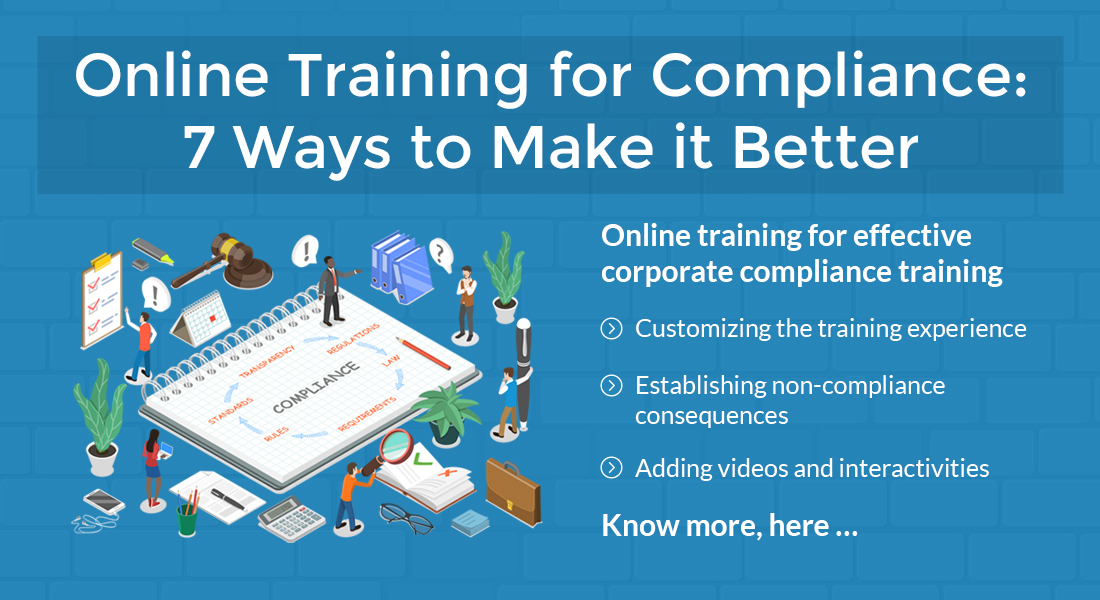7 Elements to Design Effective Compliance Training Courses

Compliance training! Might seem like a heavy word but it is absolutely crucial. Especially because it can save you, your employees, and the organization from all the unwanted trouble and liability. Now that sounds more fun and interesting. Right? Well, it is important to pay attention and conduct compliance training for a number of reasons. To begin with, it helps in risk management, i.e., it reduces the risk of legal liability followed by protecting your company reputation, better employee morale and productivity, etc.
Now that you understand how important compliance training is. It’s time to draw your attention to another equally important aspect, i.e., designing effective compliance training courses. It is integral in ensuring all the above mentioned benefits. Without a proper compliance training program and relevant course material, there might remain some gaps and pitfalls in the learning process which can eventually impact the overall success and functioning of the company.
Designing Effective Compliance Training Courses is Easy Now!
Here are the seven elements you need to keep in mind:
- Set clear learning objectives
- Use real-world scenarios
- Keep the content simple
- Make it interactive
- Use visuals
- Provide regular training
- Measure effectiveness
Therefore, designing effective training courses is vital. And for that, we’ve covered 7 elements in this blog that are worth paying attention to. So why delay?
Let’s explore!
Top 7 Elements to Design Effective Compliance Training Courses
Set Clear Learning Objectives
Learning objectives play a crucial role in setting the stage for your training courses. Therefore, in compliance training courses too, it is really important to set definite learning objectives to ensure effective training material. Because it is totally based on the learning objectives, how you go about creating the course outline and which instructional design strategy you select. Apart from these two, even the eLearning interactivities, assessments, etc., are finalized based on the learning objectives.

So how do you set clear learning objectives? Try to identify and understand what it is that your employees should learn by taking up this training course. Based on the answers, set specific goals and these goals will help you in designing and developing an effective compliance training course.
→ Download Now: Instructional Design 101
Use Real-World Scenarios
We often tend to remember things that we can relate to or visualize around us. Your learners are no different! Therefore, to ensure effective compliance training courses, don’t forget to leverage real-world scenarios and situations. They capture the interest of the learner with the very possibility of something being true and your learners can definitely imagine themselves in the situation. These elements maximize the impact of the compliance program.
For real-world scenarios, you can use case studies, practical examples, etc., which generate awareness among your learners and enable them to understand how the set policies and procedures actually work. It offers them a deeper understanding and insight into the impact of compliance on their work and the organization, thereby reinforcing the importance of compliance in their role.
Keep the Content Simple
Keeping the content simple is the key to ensure effective training courses. So don’t overwhelm your learners with excess, irrelevant information that might not actually contribute toward the learning goals. Instead the information overload might stress and confuse the learners before they even begin the compliance training course. Therefore, to put forward the relevant content, try segregating the content based on need-to-know and nice-to-know basis.

Apart from the content simplicity, make sure that you use simple, easy-to-understand language. Break down the content into small, concise nuggets of information which are better to recall and implement. That’s right! It will help you convey the desired message in a more persuasive and clear manner. Therefore, try to avoid jargon or complex terminology.
Make it Interactive
For effective compliance training courses, you need to ensure learner engagement and information retention. These two elements are important determinants of the training ROI. Learner engagement keeps the learner alert and attentive, thereby tackling issues such as distraction, boredom, inactivity, etc. This in turn boosts retention and recall. So you should leverage various types of interactive elements into your compliance training.
It can be quizzes, gamification, simulations, storytelling, videos, animations, audio, infographics, branching scenarios, etc., to create an immersive learning experience for your learners. This encourages active participation and promotes better retention among the learners. Check out the video below to learn about the 5 storytelling tips to ensure effective corporate training.
Use Visuals
It is well-known that humans are visual learners. Therefore, incorporating visual aids in your compliance training courses significantly enhances their effectiveness. So try using images, diagrams, mind maps, infographics, charts, videos, etc., to illustrate complex concepts, processes, or regulations.
This helps in improving the learner understanding and implementation of the concepts. Moreover, these components make it easy to grasp information and retain it for a longer duration as these visuals help break the text monotony.
Provide Regular Training
Compliance laws and regulations change and are updated quite frequently. Therefore, it’s crucial to provide compliance training to your employees from time to time so that they are informed and up-to-date on the latest policies and procedures. This will enable them to avoid any sanctions or risks.
So conduct regular training sessions and assign relevant regulatory compliance courses. Furthermore, set up communication channels that are solely dedicated to compliance updates to help your employees regarding knowledge reinforcement and application of the compliance guidelines.
Measure Effectiveness
Evaluate the effectiveness of your compliance training courses to analyze the overall success and impact of your training program. You can incorporate eLearning assessments during the training courses or at the end of the session. It will help you understand how well your learners have understood the concepts and how well are they able to apply them.
You can even provide your learners with different scenarios and role-based assessments that will offer you insight into how they actually behave in tricky situations. This further enables you to identify the knowledge gaps and plan your next step. For example, you can decide to assign some additional courses that might help the learner gain a better understanding or have a face-to-face interaction, based on the learner analytics.
Parting Thoughts!
It is important to ensure that your employees are equipped with the latest knowledge and skills necessary to navigate the complex landscape of regulations and contribute to a culture of compliance within your organization. Therefore, designing effective compliance training courses is essential and requires a thoughtful and strategic approach. Now that you know the 7 major elements, give it a try and pave your way to a successful compliance training program. Along with the elements mentioned in this blog, having a thorough knowledge of instructional design is highly recommended. So check out our handy guide to leave no stone unturned.





